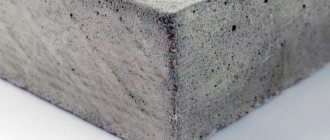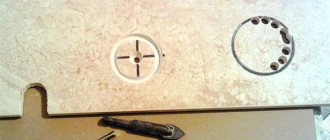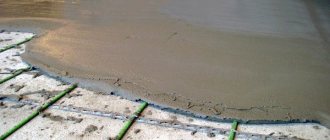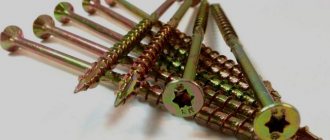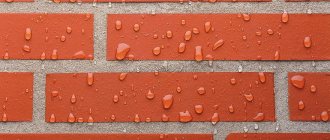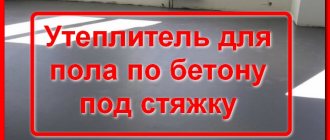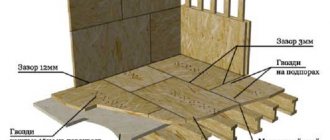- 1 Attaching foam to concrete with glue
- 2 Using dowels
- 3 Gluing with liquid nails
- 4 Bonding with foam
- 5 Additional recommendations
- 6 Conclusions
Polystyrene foam is used as insulation, since its thermal insulation properties are higher than those of natural materials, and the cold buildings in which it is used are mainly made of concrete. Often polystyrene foam needs to be attached to surfaces where it is impractical to assemble rigid sheathing (walls, ceilings, facades). In such situations, sheets of material are attached using a variety of methods and adhesives. The right technological solutions make the work easier. So, how to glue foam to concrete?
Attaching foam to concrete with glue
It is optimal to use special glue in powder form with polystyrene foam. You can also use adhesive compositions for ceramic tiles and facades (frost-resistant). Their basis is cement with the addition of binding polymers. The glue must be diluted with warm water before use. Such compositions reliably adhere to concrete, are moisture resistant, do not react to temperature changes, and last a long time.
Limitation - adhesives are used at positive air temperatures. It is better to knead using a drill with an attachment to prevent clumping. After settling for 5 hours, the mixture is stirred again. Then the glue must be used within 2 hours. The fastening mixture is applied to the insulation material. The slab should be glued by pressing it to the surface and holding it in this position for several minutes.
It is necessary to exclude the formation of an air “plug” under it. After installing the slab in an interval of 2 - 3 minutes, it is possible to correct its position on the surface. The final hardening period is 3 days. The method of applying glue depends on the height of the differences in irregularities on the surface. When they are within 50 mm, the composition is applied in wide dashed stripes (gaps for air to escape).
If the deformation differences are up to 15 mm, the substance is laid in intermittent strips with a protective distance of 20 mm from the edges of the slab. A little glue is applied to the middle of the area. When the concrete surface is almost flat (height difference is about 3 mm), a notched trowel is used to lay the adhesive on it so that it covers the entire surface. The excess squeezed out from under the slabs is removed with a dampened cloth. Adhesive compositions can be in ready-to-use form.
Bitumen adhesive has hydrophobic properties, frost-resistant, and flammable. Needs heating to 20 degrees at an air temperature of about 0 degrees. Apply with a notched trowel and provide adhesion within 20 minutes. Bitumen-latex emulsion mastic does not heat up before application, is resistant to low temperatures, and can be laid on a wet concrete surface. It hardens in a time interval from 3 hours to one day.
Another alternative is an adhesive, dense liquid based on rubber (dimethylpolysiloxane), which vulcanizes in air within 24 hours to form strong compounds. The temperature range for its vulcanization is from minus 60 to plus 300 degrees.
Return to contents
Adhesive mastic
Coating adhesive mastic is made from a mixture of petroleum bitumen, mineral fibers, organic solvent and various technological additives. It looks like a paste-like mass of uniform consistency.
This composition has the following advantages over analogues:
- Mastic does not lose its properties in conditions of high air humidity.
- Available in ready-made form, does not require dilution.
- Allows you to create an additional waterproofing layer between the foam and the wall.
- Dries completely in 20-25 minutes.
- Provides a durable, reliable connection between the foam and the concrete wall.
Mastic is a flammable material. Its use near open sources of fire is not allowed.
Features of application
Before starting work, you need to carefully prepare the walls. To do this, they are cleaned of dirt and dust, and a layer of primer is applied. If there are traces of plaster or whitewash on the surfaces, they must be removed with a spatula.
The mastic is applied to the slabs in a thin layer. A comb spatula helps with this. The composition can be applied in strips or in separate sections.
Each sheet is pressed against the wall for 20 minutes. For this purpose, temporary supports are used. If the surfaces are uneven, the plates are additionally secured with dowels.
All work is carried out in calm, dry weather. The ambient temperature must be at least -5 degrees Celsius. It is prohibited to use mastic in a room where natural or forced ventilation is not equipped.
The range of products for gluing foam plastic to concrete is huge. When choosing, you need to focus on the size and characteristics of the visit, as well as financial capabilities. You should purchase glue from a trusted store with a good reputation. Only there you can buy safe and high-quality goods.
Using dowels
Fastening polystyrene foam using dowels.
A simple, inexpensive, quick and durable glueless method of fastening polystyrene foam, however, requiring the use of a hammer drill and the required number of umbrella dowels. Their length is selected sufficient for reliable fastening of the slabs to the concrete base (taking into account the thickness of the sheets). On a clean, flat surface, a lower starting level is set, from which installation begins.
Each sheet is fastened with three dowels: one in the middle and two in the corners, so that their “umbrellas” press the corners of adjacent slabs. A gap of 3 mm is formed between the sheets - a deformation-temperature seam, which eliminates mutual deformation of the plates during daily and seasonal changes in temperature and humidity. Sealant is applied to the seams.
Return to contents
Consumption per 1m²
The amount of consumption of adhesive compositions depends on the method of application. Adhesive foam is distributed pointwise. This will also save material.
The consumption of foam adhesive from 1 cylinder is for 10-12 m² of concrete base. Depends on the brand of product and method of use.
Video: how many sheets of polystyrene foam can be glued to adhesive foam.
Powdered substances are sold in 25 kg bags. Shelf life 6 months. They differ in properties and consumption. Dry materials for gluing thermal insulation are used at a rate of 6 kg/m². The minimum amount that can be applied is 3 kg/m². Application depending on brand:
- “Ceresite” will need 6 kg/m²;
- “Knauf” - 4 kg/m²;
- "Titan" - 6 kg/m².
Consumption will be less if applied in a thin layer. Using a notched trowel will also help save material.
Bonding with liquid nails
Another alternative way to glue polystyrene sheets. Suitable only for smooth concrete surfaces. The offer of liquid nails is extensive, so it is advisable to familiarize yourself with their purpose, conditions of use and operation indicated on the packaging. Compositions are created for various pairs of materials to be bonded, including the pair polystyrene foam and concrete. This product is a polymer paste composition to which components have been added that improve adhesive properties.
Fastening with liquid nails.
Thanks to this, liquid nails are stronger than powder adhesives and harden even at high humidity. However, there is a significant drawback - the compounds are poisonous, so you should work with gloves. Such adhesives are packaged in oblong tubes, which are inserted into mounting “guns”. The benefits of using them include:
- the highest strength of materials connection;
- heat resistance;
- low technological consumption;
- complete hardening of the joint within 24 hours;
- frost resistance;
- efficiency and ease of installation;
- absence of odors and short setting time (from 20 to 40 minutes).
The latter increases the labor intensity of the work when the slabs are to be mounted on the ceiling (equipment, patience and skills are required). The composition will firmly adhere to polystyrene foam when the surface of the concrete is leveled, cleaned and dried. The substance squeezed out of the tube with a “gun” is located on the foam plastic in a small volume at several points, and not over the entire sheet area, as, for example, in the case of applying polyurethane foam. The slabs should be glued, providing pressure over the entire surface for a sufficiently long time so that the liquid nails set. Then the seams between the sheets are treated with polyurethane foam (sealant).
Return to contents
A few important tips before starting installation
Regardless of which method you choose for installing foam plastic on concrete, remember that you absolutely always need to clean the insulated surface from unstable areas and dust particles, which in the future can reduce the adhesive properties of the surfaces. In addition, it is important to carry out high-quality work to remove deep cracks and strongly protruding irregularities, as well as carry out soil work over the entire area of the working surface in order to achieve the best results.
So, as you can see, today it is impossible to unambiguously decide on the choice of material for installing polystyrene foam insulation material on concrete, since there are a huge number of parameters that at any time can change the need to use any method. Remember that you need to choose an adhesive solution in accordance with the operating conditions, the characteristics of the wall, as well as your financial capabilities.
Bonding with foam
Foam adhesive for polystyrene foam.
You can glue polystyrene foam to a flat concrete surface using a special foam adhesive. This takes a little time. This method is relatively inexpensive. At the same time, the material can also be glued to regular polyurethane foam. However, this will increase the work time, since you will have to press the slabs against the surface with force for a long time.
If this is not done, due to the increase in foam volume, the sheets will swell and rise above the surface, and the seams will separate. Before using foam adhesive, you should make sure that the contents of the tube are intended for foam plastic (and not foam concrete) and find out the conditions of use. The use of special foam is possible even without priming; it is enough to clean the concrete surface from dirt and moisten it for better adhesion.
The advantages of this composition are:
- acceptable adhesion;
- the ability to glue slabs at low temperatures inside and outside buildings;
- no odors;
- moisture resistance;
- the ability to take long breaks during editing;
- frost resistance;
- no shrinkage;
- biological resistance;
- safety (fire, chemical);
- ease of use.
The disadvantages of this substance are that the foam needs protection from UV rays, it requires washing the mounting “gun” during long breaks in work, and also that the adhesion force (holding capacity) with smooth concrete surfaces is weakened.
You should also be careful not to get the composition on the mucous membranes of the eyes. Special foam is filled into standard cylinders filled with a polyurethane compound. Before use, it is installed in a mounting “gun”, which regulates the release of the substance. The can is shaken first and can be heated in warm water. The temperature for using the cylinder is approximately plus 20 degrees.
The foam can be placed on concrete or foam, covering at least 40% of the area under the sheet. The patterns for its application are stripes along the perimeter of the slabs or in a checkerboard pattern (with indentations from the edges), in the center it is squeezed out in a zigzag manner (necessary when the surface is not flat enough). Then a little time is given for the mixture to soak into the surface to improve adhesion. Any foam that appears is removed. This composition is used to foam the seams between sheets of material.
Return to contents
Requirements
Some adhesives contain substances that destroy foam. Mixtures containing:
- ether;
- petrol;
- kerosene;
- alcohol;
- ketone.
To know how to properly glue polystyrene foam to concrete, you also need to take into account the scale of the work and the installation location. Some mixtures cannot withstand low and high temperatures.
Some adhesives are not profitable to use in large volumes. Before buying a chemical, you need to carefully read the composition. It is recommended to pay attention to the properties and advice of specialists.
Additional recommendations
Installation of the material must begin from the bottom up.
Expanded polystyrene is not hygroscopic, so free water should not be a component of the adhesive, otherwise the boards will separate from the load-bearing surface. You should also prevent their contact with adhesives containing solvents (gasoline, acetone), which destroy the structure of the material. The purpose of adhesive compositions and the conditions for their use should be determined from the manufacturer’s recommendations on the packaging.
Work begins with ensuring high adhesion of concrete surfaces (cleaning from dust, building materials, greasy stains, priming) with an adhesive applied to the insulation boards. Before they begin, deep defects and cracks are widened and sealed with sand-cement mortar, then the surface is primed again.
Expanded polystyrene sheets are glued from the bottom up from the level line. Adhesive compositions are applied in such a way as to avoid the formation of air plugs under the surface of the sheets. The joints between the plates are not specially glued, since they are subsequently filled with sealant.
In some cases (due to the long setting time of the mixtures), it is necessary to forcibly hold the slabs pressed with their entire plane to the concrete surface until the mixture sets. All thermal protection after the glue, foam or liquid nails have hardened can be additionally secured with dowels. Their number on a sheet can be more than five (center and 4 corners) if it has a significant area.
Return to contents
Rules for choosing an adhesive composition
Today, dozens of types of adhesive compositions are presented in stores. Not everyone is suitable for polystyrene foam. Some substances simply corrode the material. You cannot purchase glue that contains the following components:
- Alcohols.
- Ketones.
- Amines.
- Gas derivatives: hexane, propane.
- Substances obtained as a result of hydrocarbon processing: kerosene, gasoline.
- Ethers.
When choosing glue, the location of the work is taken into account. Some compounds cannot withstand low temperatures and are therefore not suitable for insulating building facades. The means for fixing foam plastic to a concrete wall are liquid nails, dry mixtures, mounting adhesive - foam, PVA, adhesive mastic.
Insulation of the building facade
Insulation of walls with penoplex
The main part of heat loss occurs through external walls. Before you begin insulating the facade, it is necessary to carry out preparatory work, which includes:
- cleaning the wall surface from dust and other contaminants;
- leveling with plaster;
- for better adhesion, notches should be applied to a smooth surface using an ax;
- in addition, it is necessary to apply a layer of primer, for this a concrete contact primer would be a good choice.
Read about how to apply primer to walls in this article.
Maybe,
Methods for gluing foam boards
To increase the effectiveness of thermal insulation, the slabs must be glued to each other. At the same time, it is important to choose the right adhesive that does not contain components that damage the foam. These include:
- alcohol-based solutions;
- solvents containing acetone;
- Oil and gas products.
The best options for gluing foam boards are:
- "liquid Nails";
- polyurethane glue;
- PVA.
It is impossible to give an unambiguous answer to the question of what is the best way to attach polystyrene foam to a particular surface. This depends on a number of factors, including the conditions in which the insulation will be used. If any controversial issues arise while carrying out the work yourself, consult with specialists.
conclusions
Expanded polystyrene boards are an effective lightweight thermal insulation material that does not require lathing for installation indoors or outdoors.
Foam plastic is not in danger of getting wet or caking, and if you carry out insulation according to technology, ensuring the material is protected from ultraviolet radiation and mechanical damage, then for the next 25–50 years you can forget about cold and damp walls in your home. In addition to protection from external factors, a very important point in foam insulation technology is the correct fastening of the slabs to the base surfaces (walls, ceilings, slopes). In general, all methods can be divided into three groups:
- on dowels with an umbrella hat;
- for plaster mixtures;
- for adhesive compositions.
In the first case, fastening occurs solely by screwing dowels into the walls. The foam sheets are attached at five points - in the corners and in the center. Corner dowels also secure the joints of individual sheets. The joints themselves are additionally sealed with sealant, which improves the thermal insulation qualities.
First of all, using the starting profile, the bottom row of foam is attached, then the master moves from top to bottom along the entire perimeter of the wall. It is important to leave gaps between individual slabs of at least 3 mm, since foam also expands and contracts with temperature changes. Dowels are the cheapest way to secure slabs.
Plaster mixtures are another very popular option for attaching foam plastic, which is mainly used for insulating concrete and brick walls outside and inside the building. It goes without saying that a special plaster composition is used for this - ordinary cement plaster is unsuitable for this. Some companies produce universal mixtures that are suitable both for fixing foam plastic boards and for plastering; some divide the mixtures into two groups - one only for gluing, the other only for plastering.
Adhesive compositions for polystyrene foam - not every adhesive is suitable for polystyrene foam, and many can even destroy its structure by reacting with it. Therefore, experiments are unnecessary here. Pasting concrete, brick and metal walls with foam plastic can be done using construction PVA, universal liquid nails, polyurethane foam or special polyurethane glue. Each method has its own characteristics, which we will discuss below.
Possible errors and difficulties
The technology for installing Penoplex on the external concrete surfaces of a house is not complicated; it is carefully described by the insulation manufacturer and the technician just has to follow all the instructions.
The largest number of errors that lead to negative results are made at the stage of choosing the material, calculating the thickness of Penoplex and selecting fixing agents.
In this regard, if the insulator thickness is incorrectly selected, the effect will not be achieved, the house will still be cold and a new protection system will need to be installed. Unstable fixation of the slabs will lead to them starting to peel off from the wall, followed by collapse.
Also in practice, there are situations when the owner, in pursuit of savings, does not perform waterproofing or does not lay a reinforcing layer in the thermal insulation cake. This shifts the dew point to the outer surface of the wall, it begins to become covered with condensation, water flows onto the foundation and leads to the destruction of the main supporting structures of the house.
Reply to reader
We welcome you, Peter, to the vastness of our website! You are right, indeed, the foam will corrode if you use acetone-based compounds, so do not use them under any circumstances. Now we will name the 3 most common ways to solve the problem assigned to you. But first…
Preparing the concrete surface
Regardless of what type of glue you use, the surface must be properly prepared to obtain a reliable connection.
The procedure will not take much of your time, but it must be done.
- First of all, take a hard spatula and go over the entire surface of the ceiling, removing small debris and possible growths from it. If there are frozen pieces of concrete, you may need the help of a hammer drill. All protruding metal parts are cut off with a grinder.
- Mark the ceiling with a brush and prime it thoroughly - preferably in two layers.
- After the primer has dried, seal the seams between the concrete slabs with gypsum or cement plaster. An option with polyurethane foam is possible, the main thing is to ensure insulation from drafts and prevent large unevenness (excess foam is cut off with a sharp knife).
- Separately apply primer to the dried plaster.
Basic moments
Let's look at how to properly attach polystyrene foam. Laying polystyrene foam is done from the bottom row up. Two fastening options are used: in rows and pyramidally.
In the first case, the work is carried out sequentially; after laying the first row, the second is laid along the entire perimeter.
The second option is more complex, but also justified under certain conditions. It allows you to reduce the time it takes to move lifting equipment to a height.
In this case, the lower level is glued around the perimeter, then the corners of the building are laid out with foam plastic in a pyramid.
In this case, the top of the pyramid is located on the corner of the building at the highest point. Then the sheets are attached to the remaining sections of the wall.
Description of brands
Among the highest quality brands:
- Ceresit Ct 83 Strong Fix;
- Ceresit Express Ct 84;
- Tytan Styro 753 Gun;
- Knauf Klebespachtel;
- Prospectors Teploizol;
- TechnoNIKOL Professional;
- Penoplex Fastfix;
- Bitumast.
Ceresit CT 83
Ceresit ST 83 brand adhesive is very durable, can withstand heavy loads, and has high adhesion. The mixture is vapor-permeable, so moisture does not linger in the room where the heat-insulating boards were attached with the plaster-adhesive mixture. Does not ignite when exposed to fire. The composition is used to attach heavy slabs of large thickness (up to 20 cm) to the wall outside the house.
You can work with the ST 83 brand at zero temperatures, but then the powder is diluted in heated water to +30 °C.
Advantages:
- environmental friendliness;
- low consumption;
- vapor permeability;
- speed of preparation.
Flaws:
- price;
- inadmissibility of gluing on other paints and varnishes;
- sticker on concrete only three months after it is poured;
- You can mix a good solution without lumps only with a mixer or a drill with a mixing attachment at 400-800 rpm.
Ceresit CT 84
This is polyurethane foam, the basis of the composition is polyurethane and flammable gas. ST 84 – frost-resistant glue. Used at sub-zero temperatures down to -10 °C. In cold weather, the composition hardens several times longer, up to 7-10 hours. While in warm weather, hardening takes only 2 hours.
ST 84 is applied first along the perimeter of the heat-insulating sheet, then diagonally. Presses against the surface. Exposed mixture residues can only be removed with a solvent.
Advantages:
- absence of freons;
- moisture and water resistance;
- consumption;
- simplicity and speed of installation.
Flaws:
- poor adhesion to paint and varnish coatings;
- mandatory fastening with dowels;
- Before applying to foam blocks, the latter require priming.
Tytan Styro 753 Gun
Titan Styro foam in 750 g cans. Application requires a construction gun, which speeds up installation.
The foam layer is no more than 5 mm, this is a drawback, because outside the house such fastening is unreliable. Additionally, fastening with dowels is required.
Bonds EPS sheets to brick, concrete, mastic, plaster and cement bases.
Advantages:
- economical consumption;
- the foam is ready to use, does not require preparation;
- simplicity and speed of application (with a construction gun);
- good adhesion to metal, concrete, brick, plastic and wooden surfaces.
Flaws:
- price;
- requires additional fastening with dowels;
- operation only at t °C above zero.
Knauf Klebespachtel
Powder that is diluted with water. Packaging: 25 kg. For interior and exterior work.
Application is possible by machine using G4 and Monojet pumps. This significantly speeds up coverage of large areas.
Suitable for EPPS.
Advantages:
- Can be used for reinforcement;
- setting time – 1 hour;
- the presence of a machine application method;
- operating temperature range.
Flaws:
- consumption;
- packaging is heavy, inconvenient for transportation;
- takes a long time to apply by hand.
Prospectors Teploizol
Manufacturer – Russia. Release form: powder. Fixing foam plastic to the wall outside the house. In original packaging the shelf life is up to one year.
Advantages:
- no need to pre-treat the surface;
- low consumption;
- used for reinforcement;
- After mixing, the solution is suitable for three hours.
Flaws:
- high price;
- discomfort during transportation;
- slow period of complete hardening (three days);
- operating temperature only above +10 °C.
TechnoNIKOL Professional
TechnoNIKOL Professional adhesive foam has a polyurethane-based composition. Used as a sealant. Fastens all types of polystyrene foam.
Operating temperature up to 30 degrees Celsius, but not below zero.
Advantages:
- price;
- resistance to water, moisture, fungi and mold;
- the ability to correct the position of the slabs within 20 minutes after fixing;
- high adhesion;
- Suitable for external and internal installations.
Flaws:
- installation only at positive temperatures °C;
- installation only with a construction gun;
- chem. reaction when interacting with silicone and polyethylene;
- the required humidity level is 50% for rapid hardening.
Penoplex Fastfix
Penoplex is produced in 750 g cylinders, inside of which there is foam material. Used in conjunction with a mounting gun for fastening extruded and foamed polystyrene foam. Fixation is possible on concrete, brick, ceramic surfaces, and aerated concrete blocks.
It is used both outside and indoors for insulating loggias, rooms, and roofs.
Has a light blue tint. Dries in 10 hours and withstands 100 frost cycles. Installation temperature from -10 °C to +40 °C.
Apply with a construction gun in vertical continuous strips with a distance of 5 cm between each. Press the insulation sheet after 5-7 minutes and strengthen it with dowels.
Bitumast
Resinous bitumen for extruded polystyrene foam. Half a kg of mixture is consumed per 1 m2. Bitumast dries for two days. Withstands 100 freezing cycles. The gluing temperature is only above zero, up to +30 °C.
Cannot be applied to facades or inside rooms or buildings.
Bitumen adhesive needs to be pre-diluted with water. Has good adhesion to any type of substrate. The setting time is long compared to other mixtures. The sheets will have to be pressed until the polystyrene holds on itself and does not slide off. Very high price.

